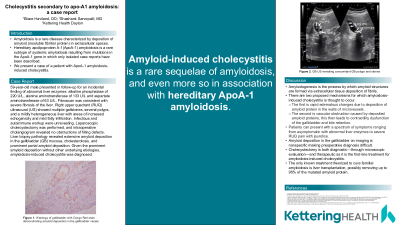Monday Poster Session
Category: Biliary/Pancreas
P1896 - Cholecystitis Secondary to Apo-A1 Amyloidosis: A Case Report
Monday, October 28, 2024
10:30 AM - 4:00 PM ET
Location: Exhibit Hall E

Has Audio

Blace Haviland, DO
Kettering Health
Huber Heights, OH
Presenting Author(s)
Blace Haviland, DO1, Shashank Sarvepalli, MD, MS2
1Kettering Health, Huber Heights, OH; 2Kettering Health Medical Group Gastroenterology, Dayton, OH
Introduction: Amyloidosis is a rare disease characterized by deposition of amyloid (insoluble fibrillar protein) in extracellular spaces. Hereditary apolipoprotein A-1(ApoA-1) amyloidosis is a rare subtype of systemic amyloidosis resulting from mutations in the ApoA-1 gene in which only isolated case reports have been described. Amyloid-induced cholecystitis is a rare sequelae of amyloidosis, and even more so in association with hereditary ApoA-1 amyloidosis. We present a case of a patient with ApoA-1 amyloidosis-induced cholecystitis.
Case Description/Methods: A 59 year-old male presented in follow-up for an incidental finding of abnormal liver enzymes: alkaline phosphatase of 220 U/L, alanine aminotransferase of 133 U/L and aspartate aminotransferase of 63 U/L. Fibroscan was consistent with severe fibrosis of the liver. Right upper quadrant (RUQ) ultrasound showed multiple gallstones, several polyps, and a mildly heterogeneous liver with areas of increased echogenicity and mild fatty infiltration. Infectious and autoimmune workup were unrevealing. Laparoscopic cholecystectomy was performed and intraoperative cholangiogram revealed no obstructions of filling defects. Liver biopsy pathology revealed extensive amyloid deposition in the gallbladder mucosa, cholesterolosis, and prominent portal amyloid deposition. Given the prominent amyloid deposition without other underlying etiologies, amyloidosis-induced cholecystitis was diagnosed.
Discussion: Amyloidogenesis is the process by which amyloid structures are formed via extracellular tissue deposition of fibrils. There are two proposed mechanisms for which amyloidosis-induced cholecystitis is thought to occur. The first is rapid edematous changes due to deposition of amyloid protein in the walls of microvessels. The second is vascular obstruction caused by deposited amyloid proteins, this then leads to contractility dysfunction of the gallbladder and bile retention. Patients can present with a spectrum of symptoms ranging from asymptomatic with abnormal liver enzymes to severe RUQ pain with jaundice. Amyloid deposition in the gallbladder on imaging is nonspecific making preoperative diagnosis difficult. Cholecystectomy is both diagnostic—through microscopic evaluation—and therapeutic as it is the first-line treatment for amyloidosis-induced cholecystitis. The only known treatment theorized to cure familial amyloidosis is liver transplantation, possibly removing up to 95% of the mutated amyloid protein.
Disclosures:
Blace Haviland, DO1, Shashank Sarvepalli, MD, MS2. P1896 - Cholecystitis Secondary to Apo-A1 Amyloidosis: A Case Report, ACG 2024 Annual Scientific Meeting Abstracts. Philadelphia, PA: American College of Gastroenterology.
1Kettering Health, Huber Heights, OH; 2Kettering Health Medical Group Gastroenterology, Dayton, OH
Introduction: Amyloidosis is a rare disease characterized by deposition of amyloid (insoluble fibrillar protein) in extracellular spaces. Hereditary apolipoprotein A-1(ApoA-1) amyloidosis is a rare subtype of systemic amyloidosis resulting from mutations in the ApoA-1 gene in which only isolated case reports have been described. Amyloid-induced cholecystitis is a rare sequelae of amyloidosis, and even more so in association with hereditary ApoA-1 amyloidosis. We present a case of a patient with ApoA-1 amyloidosis-induced cholecystitis.
Case Description/Methods: A 59 year-old male presented in follow-up for an incidental finding of abnormal liver enzymes: alkaline phosphatase of 220 U/L, alanine aminotransferase of 133 U/L and aspartate aminotransferase of 63 U/L. Fibroscan was consistent with severe fibrosis of the liver. Right upper quadrant (RUQ) ultrasound showed multiple gallstones, several polyps, and a mildly heterogeneous liver with areas of increased echogenicity and mild fatty infiltration. Infectious and autoimmune workup were unrevealing. Laparoscopic cholecystectomy was performed and intraoperative cholangiogram revealed no obstructions of filling defects. Liver biopsy pathology revealed extensive amyloid deposition in the gallbladder mucosa, cholesterolosis, and prominent portal amyloid deposition. Given the prominent amyloid deposition without other underlying etiologies, amyloidosis-induced cholecystitis was diagnosed.
Discussion: Amyloidogenesis is the process by which amyloid structures are formed via extracellular tissue deposition of fibrils. There are two proposed mechanisms for which amyloidosis-induced cholecystitis is thought to occur. The first is rapid edematous changes due to deposition of amyloid protein in the walls of microvessels. The second is vascular obstruction caused by deposited amyloid proteins, this then leads to contractility dysfunction of the gallbladder and bile retention. Patients can present with a spectrum of symptoms ranging from asymptomatic with abnormal liver enzymes to severe RUQ pain with jaundice. Amyloid deposition in the gallbladder on imaging is nonspecific making preoperative diagnosis difficult. Cholecystectomy is both diagnostic—through microscopic evaluation—and therapeutic as it is the first-line treatment for amyloidosis-induced cholecystitis. The only known treatment theorized to cure familial amyloidosis is liver transplantation, possibly removing up to 95% of the mutated amyloid protein.
Disclosures:
Blace Haviland indicated no relevant financial relationships.
Shashank Sarvepalli indicated no relevant financial relationships.
Blace Haviland, DO1, Shashank Sarvepalli, MD, MS2. P1896 - Cholecystitis Secondary to Apo-A1 Amyloidosis: A Case Report, ACG 2024 Annual Scientific Meeting Abstracts. Philadelphia, PA: American College of Gastroenterology.
